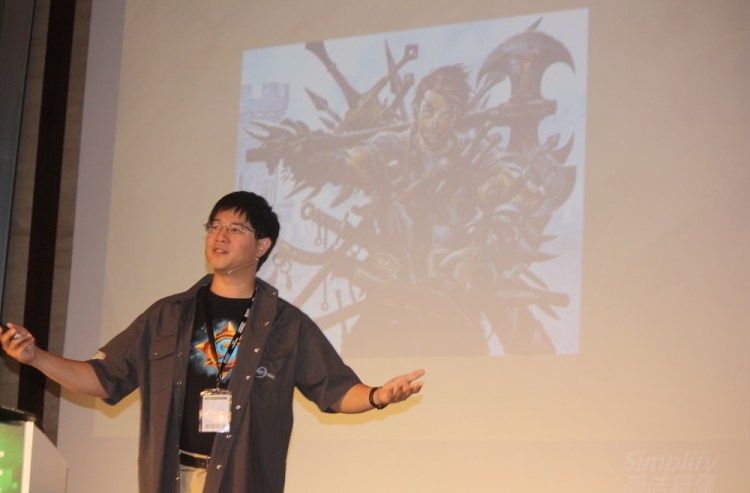Disclosure: The organizers of ChinaJoy paid my way to Shanghai. Our coverage remains objective.
SHANGHAI — Hearthstone: Heroes of Warcraft is one of those rare free-to-play games that has succeeded on both the PC and mobile devices. It has been downloaded more than 10 million times and earned an 88 out of 100 ranking on review score aggregator Metacritic.
Publisher Blizzard Entertainment hasn’t said how much money Hearthstone is generating, but it’s considerable. One analyst estimated that this digital card-battler and Heroes of the Storm, an online arena-strategy game in the vein of League of Legends or Dota 2, could generate $200 million in revenue in a year. That represents a huge stride in the transition from traditional to digital games for Blizzard.
One of the reasons Hearthstone has done so well is that Blizzard spent a lot of time crafting it for both new players and hardcore Warcraft fans, according to Hamilton Chu, the executive producer of the game at Blizzard Entertainment, a division of Activision Blizzard. Chu talked about a lot of lessons they learned about game design in a recent talk in front of a big audience of Chinese game makers at the ChinaJoy Expo in Shanghai. The multibillion-dollar Chinese online and mobile game markets are a big opportunity for Hearthstone, and Chu’s talk had an addition motive: to stoke interest in the game.
Here’s Chu’s tips and tricks from designing Hearthstone.
1. Iterate
Chu said that Blizzard’s team created cardboard playing cards almost every day during while designing Hearthstone. They knew they would convert those cards to digital later, but they could easily print them out and play games.
“It let us get rid of bad ideas as fast as possible and hopefully move on to the good ideas,” he said. “We took six or nine months and focused on pure design time. We let other concerns sit on the sidelines. You sit down at a table and start playing.”
Iterating fast on new versions enables the team to come together quickly and figure out the roles for each person. Making changes to the paper-based design early on is a lot less expensive than doing it later in the design process.
2. Create simple prototypes early
Blizzard also created an Adobe Flash-based prototype. That was based on a technology that wouldn’t be in the final mobile and PC platforms, since the animation quality just wasn’t up to par. But it helped the team visualize the user interface. And once the designers were happy with the user interface, they could hand it off to the engineering team to code in the Hearthstone’s real platform, Unity.
“That ended up saving so much work,” he said. “This let us look at interface issues.
3. Share the vision
Game design leaders should communicate their vision far and wide in a way that is memorable. Most team members forget or ignore design documents, so the leaders must create simple ideas, or “stakes in the ground,” about what the game is to be all about.
The designers wanted Hearthstone to be approachable, safe, and immediately fun for both old Warcraft or card fans and new players. Blizzard captured these ideas with phrases and funny pictures.
“Make sure people are working on the same game,” Chu said. “If the game is not coming together, people need to be told. They will be angry if they are working on things that have to be thrown away. It’s just a bad scene.”
Under this kind of design process, everybody could be a designer and contribute their ideas.
4. Question the basics
Blizzard’s team decided it didn’t want to make a card game like others that preceded it because those games are too complicated. As an example, other games forced you to follow a certain order for actions, and that meant you had to learn them. In this game, they obviated the need for a big tutorial by letting players do things in any order.
The team also got rid of constant resource management, which took you away from the action and wasn’t that fun. It slowed down the turn and didn’t contribute anything. It also tested ideas that gave players powerful surprise attacks. But the attacks proved too decisive in ending matches, and so Blizzard took those out.
5. Keep it deep
Chu said that Blizzard distinguishes between complexity and depth. It wants players to enjoy games, like World of Warcraft in its 10th year, for decades. It enables that through depth, but not complexity.
Complexity is about all the different things you need to understand before you can make decisions in the game. Depth gives you a wide range of options to take once you understand the game.




